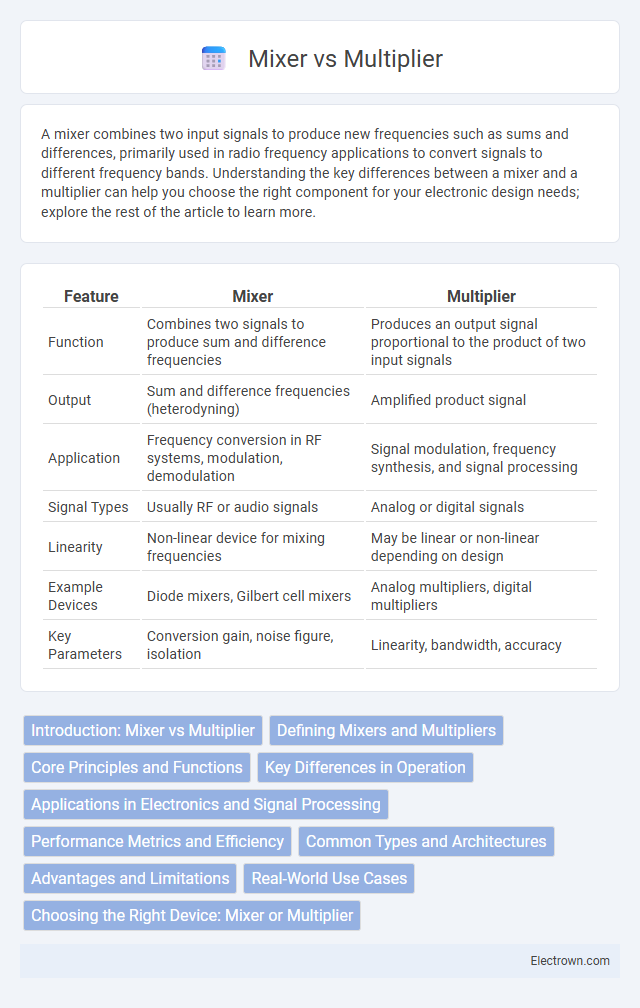A mixer combines two input signals to produce new frequencies such as sums and differences, primarily used in radio frequency applications to convert signals to different frequency bands. Understanding the key differences between a mixer and a multiplier can help you choose the right component for your electronic design needs; explore the rest of the article to learn more.
Table of Comparison
| Feature | Mixer | Multiplier |
|---|---|---|
| Function | Combines two signals to produce sum and difference frequencies | Produces an output signal proportional to the product of two input signals |
| Output | Sum and difference frequencies (heterodyning) | Amplified product signal |
| Application | Frequency conversion in RF systems, modulation, demodulation | Signal modulation, frequency synthesis, and signal processing |
| Signal Types | Usually RF or audio signals | Analog or digital signals |
| Linearity | Non-linear device for mixing frequencies | May be linear or non-linear depending on design |
| Example Devices | Diode mixers, Gilbert cell mixers | Analog multipliers, digital multipliers |
| Key Parameters | Conversion gain, noise figure, isolation | Linearity, bandwidth, accuracy |
Introduction: Mixer vs Multiplier
A mixer is an electronic device that combines two input signals, producing output frequencies at the sum and difference of the original frequencies, commonly used in RF and communication systems. A multiplier, on the other hand, specifically generates an output signal proportional to the product of the input amplitudes, often employed in signal modulation and frequency synthesis. Your choice between a mixer and multiplier depends on the application requirements such as frequency conversion or amplitude modulation.
Defining Mixers and Multipliers
Mixers are electronic components designed to combine two or more input signals, producing output frequencies such as the sum and difference of the original frequencies. Multipliers perform mathematical multiplication of input signals, often used in applications requiring amplitude modulation or frequency synthesis. Both devices play crucial roles in radio frequency (RF) and signal processing systems, with mixers primarily facilitating frequency translation and multipliers enabling signal scaling or modulation.
Core Principles and Functions
Mixers and multipliers both perform signal processing functions but differ fundamentally in their core principles. A mixer combines two input signals to produce new frequencies, typically the sum and difference of the original frequencies, essential in frequency translation for communication systems. In contrast, a multiplier directly multiplies two signals point-by-point, enabling amplitude modulation and nonlinear signal processing applications.
Key Differences in Operation
Mixers combine two or more signals into a single output, typically used in frequency conversion, while multipliers generate a signal whose frequency is the sum or difference of the input frequencies. Mixers perform nonlinear mixing to produce intermodulation products, whereas multipliers often use analog or digital circuits to multiply signal amplitudes directly. Your choice between a mixer and multiplier depends on whether the application requires frequency translation or signal amplitude modification.
Applications in Electronics and Signal Processing
Mixers are essential in radio frequency (RF) communication systems for frequency translation, enabling modulation and demodulation in transmitters and receivers. Multipliers are widely used in analog signal processing, such as amplitude modulation (AM) and phase detection, providing precise signal multiplication for waveform shaping. Both devices play critical roles in electronic instrumentation and audio signal processing, enhancing signal manipulation and analysis capabilities.
Performance Metrics and Efficiency
Mixers and multipliers differ significantly in performance metrics and efficiency, with mixers excelling in frequency translation accuracy and lower noise figures, making them ideal for signal processing applications. Multipliers offer higher linearity and bandwidth, enabling efficient amplitude modulation and signal scaling tasks. To optimize your system's performance, selecting the appropriate device based on parameters like conversion gain and power consumption is crucial.
Common Types and Architectures
Mixers commonly include passive diode, active transistor, and Gilbert cell architectures, each optimized for frequency conversion and linearity in RF systems. Multipliers often employ Gilbert cell designs or analog multiplier ICs like the AD633 for signal amplitude modulation or frequency synthesis with precise gain control. Key architectures in mixers focus on nonlinear element mixing for frequency translation, while multipliers emphasize linearity and proportional output for amplitude or frequency scaling applications.
Advantages and Limitations
A mixer efficiently combines multiple input signals into a single output, offering simplicity and cost-effectiveness ideal for audio and communication systems but may introduce signal distortion and noise. A multiplier performs precise mathematical multiplication of two signals, enabling advanced modulation and signal processing with high accuracy, though it often requires complex circuitry and higher power consumption. Understanding the trade-offs between mixers and multipliers helps you select the right component for your specific signal processing needs.
Real-World Use Cases
Mixers are widely used in communication systems for frequency conversion, enabling efficient signal modulation and demodulation in radios and transmitters. Multipliers play a critical role in analog signal processing, supporting applications such as amplitude modulation, frequency synthesis, and waveform generation. Practical implementations of mixers often involve heterodyne receivers, while multipliers are integral in phase-locked loops and analog computing circuits.
Choosing the Right Device: Mixer or Multiplier
Choosing the right device between a mixer and a multiplier depends on your signal processing needs. Mixers are ideal for frequency conversion, combining two signals to produce sum and difference frequencies, essential in communication systems. Your choice hinges on whether you need frequency translation (mixer) or harmonic generation and frequency multiplication (multiplier) for applications like signal synthesis.
Mixer vs Multiplier Infographic

 electrown.com
electrown.com